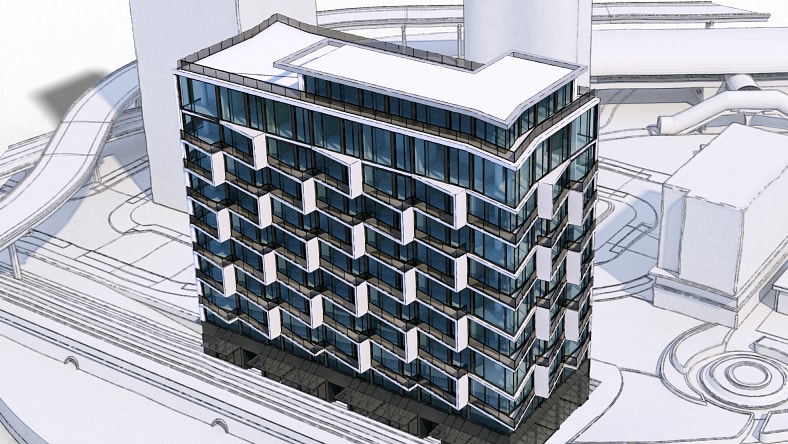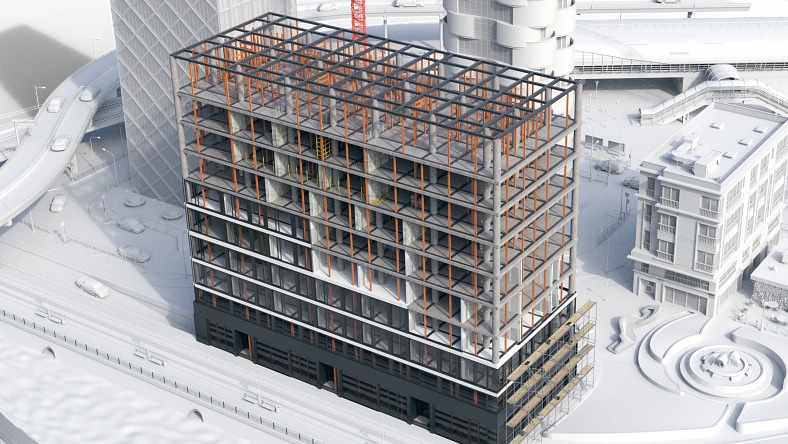& Construction

Integrated BIM tools, including Revit, AutoCAD, and Civil 3D
& Manufacturing

Professional CAD/CAM tools built on Inventor and AutoCAD
What BIM is used for (video: 2:51 min.)
BIM is used for creating and managing data during the design, construction, and operations process. BIM integrates multi-disciplinary data to create detailed digital representations that are managed in an open cloud platform for real-time collaboration. Using BIM gives you greater visibility, better decision-making, more sustainable options, and cost-savings on architecture, engineering, and construction (AEC) projects.
The process of BIM supports the creation of intelligent data that can be used throughout the lifecycle of a building or infrastructure project.
Inform project planning by combining reality capture and real-world data to generate context models of the existing built and natural environment.
Conceptual design, analysis, detailing, and documentation are performed. The preconstruction process begins using BIM data to inform scheduling and logistics.
Fabrication begins using BIM specifications. Project construction logistics are shared with trades and contractors to ensure optimum timing and efficiency.
BIM data carries over to operations and maintenance of finished assets. BIM data can be used down the road for cost-effective renovation or efficient deconstruction.
According to the UN, by 2050 the world's population will be 9.7 billion. The global AEC industry must look to smarter, more efficient ways to design and build not just as a means to keep up with global demand, but to help create spaces that are smarter and more resilient too.
BIM not only allows design and construction teams to work more efficiently, but it allows them to capture the data they create during the process to benefit operations and maintenance activities. This is why BIM mandates are increasing across the globe.
BIM is revolutionizing the way projects are delivered across industries, adding intelligence and efficiency to project execution–and connecting teams, data, and workflows at every stage of the project in the cloud for better project outcomes. Learn more.
BIM interoperability is the ability of AEC project teams to work and communicate fluidly across disciplines and industries, regardless of preferred software tools and vendors. At Autodesk, we’re committed to supporting an open and interoperable AEC software ecosystem defined by seamless data connection. Learn more.
Moving to BIM can seem like a daunting task. In this video, we take a look at two strategies that will help your firm create an effective BIM vision and manage change during your transition to BIM.
Building Information Modeling (BIM) can bring numerous benefits to the construction industry, including improved collaboration, reduced rework, and increased efficiency. Some successful use cases for BIM adoption are:
Design and construction coordination: BIM allows teams to collaborate and coordinate their work in real-time, reducing conflicts and errors during the construction process.
Clash detection: BIM can identify clashes between different building systems and components before construction begins, saving time and money.
Facility management: BIM can be used to manage and maintain buildings and infrastructure throughout their lifecycle, providing valuable data and insights for facility managers.
Prefabrication and modular construction: BIM can be used to create detailed digital models of prefabricated and modular building components, improving efficiency and reducing waste.
Sustainability: BIM can be used to analyze and optimize building performance, reducing energy consumption and environmental impact.
BIM (Building Information Modeling) technology is a process that involves creating and managing digital models of buildings, infrastructure, and other structures. Some of the new technologies used in BIM include 3D laser scanning, drones, augmented reality, and artificial intelligence. Some benefits of using BIM technology include:
Powerful BIM and CAD tools for designers, engineers, and contractors, including Revit, AutoCAD, Civil 3D, Forma Site Design, and more
Plan, design, construct, and manage buildings with powerful tools for Building Information Modeling.
Cloud-based design co-authoring, collaboration, and coordination software for architecture, engineering, and construction teams. “Pro” enables anytime, anywhere collaboration in Revit, Civil 3D, and AutoCAD Plant 3D.
Navisworks Manage, Navisworks Simulate software and the Navisworks Freedom 3D viewer for 5D analysis, design simulation, and project review.
Explore how the AEC Collection’s powerful set of BIM and CAD software provides every designer, engineer, and contractor the tools they need.
Gain deeper insights and make better design decisions earlier in the process.
Deliver optimized, coordinated designs and documentation faster.
Adopt BIM to produce optimized, coordinated designs faster.
Bring your plant projects online with integrated tools.
Elevate digital construction processes from design to build.




